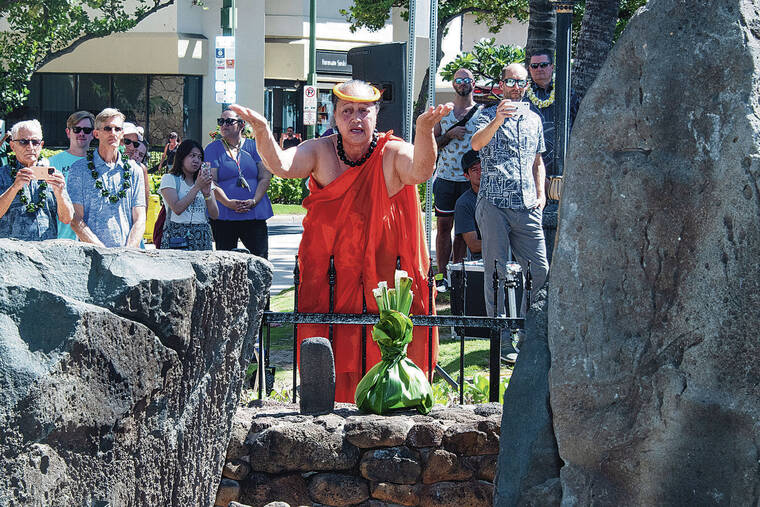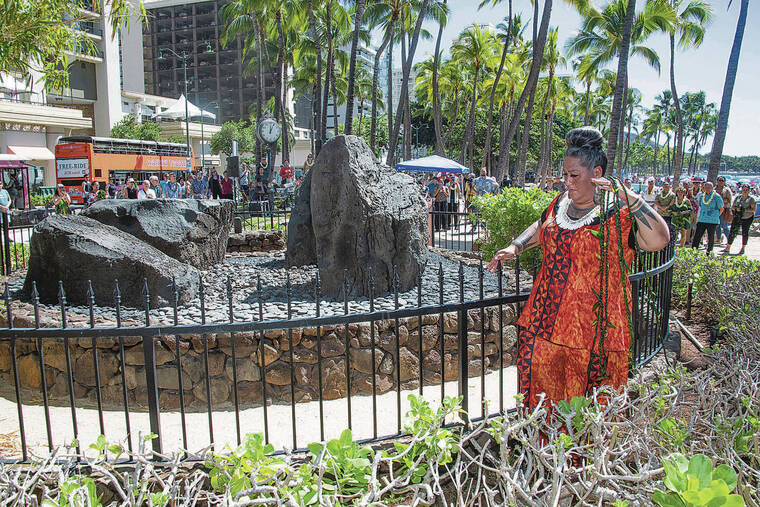The City and County of Honolulu held a blessing this week at the Healer Stones of Kapaemahu, where a new plaque was unveiled that includes a QR code to an online website with additional history and information.
The two stones date back more than 500 years, and they were placed there in honor of four healers from Tahiti who made significant impacts throughout the Hawaiian Islands with their practice.
“This is a historic day for the city,” Honolulu Mayor Rick Blangiardi said Tuesday. “I’m very proud that we’re actually here today and this has become a reality.”
The stones honor four mahu (someone of dual male and female spirit) healers named Kapaemahu (the leader of the group), Kapuni, Kinohi and Kahaloa. They were placed in Waikiki at the request of the healers, near where they had taken up residence to ensure that they would be remembered, said Dean Hamer, a researcher, director, producer and editor on the Kapaemahu team.
“They actually wanted people to know about the stones and know about them,” Hamer said. “So we’ve been doing everything we can to get the story more widely known.”
The stones were cherished by Native Hawaiian nobility until the early 1900s, when they began to see an era of neglect alongside the growing sense of disrespect toward mahu. In 1941 a bowling alley was constructed on top of the stones, until they were recovered in 1963.
In 1997 the stones were placed on an elevated platform amid an effort to restore a sense of Hawaiian culture to Waikiki. However, with nationwide debates over same-sex marriage being a major topic of controversy at the time, the plaque installed that year excluded information about their connection to gender diversity.
While the story of the stones’ connection to mahu became lost to the general public, Hamer noticed the absence of its mention on the plaque when kumu Hinaleimoana Wong-Kalu told him of the four healers about 11 years ago. The realization sparked a 10-year search for the stones’ full story, which concluded when it was rediscovered in the Hawaiian language newspapers at the University of Hawaii at Manoa archives, Hamer said.
The research shed light on the fact that the healer stones, which were known as the Wizard Stones for a time, were actually called Ka Pohaku Kahuna Kapaemahu (The Healer Stones of Kapaemahu). It also clarified the healers’ intentions and their desire to be remembered.
“It’s not like we’re commercializing the story,” Hamer said. “It’s more like we’re doing what the healers themselves wanted us to do.”
Since then, those involved on the Kapaemahu Project have been doing everything they can to share the story, Hamer said.
Joe Wilson, Hamer’s partner and director, producer and impact strategist on the Kapaemahu team, expressed that while the original story of the stones displays an appreciation for the healers and their abilities, as well as a society of love and inclusion, it also conveys a deeper message.
“I now see that somehow these great visionaries of old knew that in the future, things might change,” Wilson said. “Kapaemahu should and will be a shining example of a city that honors and celebrates its culture, diversity and all who visit or call it home.”
To continue perpetuating the history of the stones, a free virtual reality app called KAPAEMAHUAR was created so that those interested in the site can take a virtual self-guided tour of it. The link to download the app is included on the newly installed plaque.
“We wanted the app to be succinct, so that it would be something like a short introduction to before they come to the stones,” said the KAPAEMAHUAR software developer, Kari Kehau Noe. “We want to interest everybody and get them excited and know about the stones, but we want them to actually come and see the stones and appreciate their existence.”
Since beginning their research on the Kapaemahu stones, word of its story has drawn feedback from those who have said it has been helpful in feeling accepted in their gender identity, Wilson said.
Others have said the story has helped them find connection to their own gender identity, Hamer added.
“We didn’t know how people would react, but when kids that are especially sort of gender fluid, or they’re wondering about their sexuality, or they’re wondering about their gender — when they hear that story, they see themselves reflected and it’s just incredibly powerful,” he said. “That’s been incredibly moving for us.”
Linsey Dower covers ethnic and cultural affairs and is a corps member of Report for America, a national service organization that places journalists in local newsrooms to report on undercovered issues and communities.








